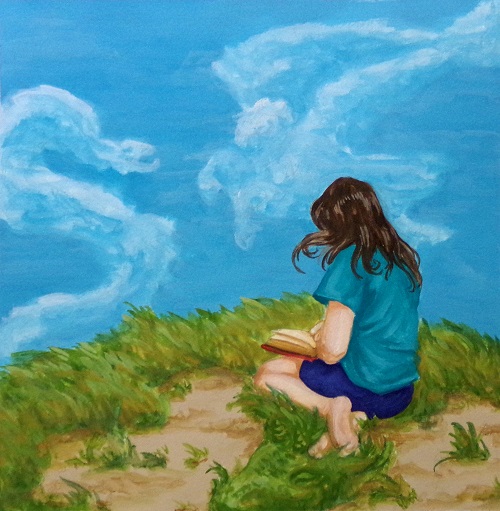Today I will begin going over my second–and longest!–day at the Cape Cod Writers Center Conference. Saturday was a very busy day, because I had four classes, the keynote luncheon, and I read an excerpt from my WIP, Within the Ironwood, during a student prose reading. 8:30 AM to 9:30 PM, followed by a half-hour drive back to my friend’s place, where I was staying. Needless to say, it was exhausting but a LOT of fun!
Saturday will be split into two parts, as otherwise it would be an extremely long blog post!
Story and Character Arc: Day One of Two
The first class I had on Saturday was my third of four classes. Michelle Hoover taught the class and she was awesome! After a brief introduction to the class and what we would be covering, she led us in a free-writing session for part of the class, during which we answered a series of questions related to our story and our protagonist.
Most of the questions involve potential spoilers, but the first one doesn’t.
Describe your protagonist’s (inner and outer) world at the onset of your story. What problems lie in the background in the protagonist’s background and/or psyche?
Branwen lives in a small kingdom in the northern part of the continent. The kingdom is known for its metal exports. The Ironwood forms part of its protective border, but is difficult to harvest due to the toughness of the trees’ wood (which is desired by other countries for magical and constructive purposes). Branwen, being the princess, is expected to rule the kingdom someday. However, due to her albinoism, she isn’t able to travel the kingdom easily and learn it from her experiences, instead forced to learn from her tutors and her father’s stories. In some ways, this makes her feel unprepared to be the ruler. Interactions with others in the past, since as other princes/princesses, have made her feel this way, as well as her own underlying insecurities.
After the free-write, we took some time to go over each question and listen to answers from various students in the class. Next, Michelle discussed various kinds of character arcs, starting with the well-known Hero’s Journey (described by Joseph Campbell). We also covered the Villain’s Journey, the Flat/Static Journey, the Existential Flat Arc, and the Heroine’s Journey, discussing various examples of each on the way.
Due to time limits, Michelle decided not to assign us homework for Sunday, instead choosing to have us do our next assignment in class. I actually did it Saturday night, however. The assignment was a simple one–choose an arc (or several) and sketch out how my story might fit to it by describing the story’s primary arc in paragraph form. This seemed similar in some ways to the three-paragraph summary I had just learned about in Writing an Airtight Narrative, but more focused on the character’s journey.
Writing an Airtight Narrative: Day Two of Three
After going over the three-paragraph summary a little more, and reading a few more of students’ examples, Lou moved on to discussing our next big step–the two-page summary. Note: this should only be 500 words long!
The purpose of the two-page summary is to determine…
- How much story you have
- How much background is needed
- What should be told or shown
- How much detail is necessary to bring the reader into the story so they can experience it
Also allowed in the two-page summary:
- Digressive background paragraphs to explain why a character does XYZ
- Subplots!
We didn’t work on our two-page summaries in class, as we didn’t have time, but I’ll admit my muse was already poking around at ideas while the class moved on to the next major step.
The five-page outline. Lou didn’t give us a word count for this one, but I estimate it’s supposed to be around 2500 words long. This is the last big step before the storyboard, and we spent the rest of Saturday’s class discussing all the fine details of what goes into these five pages.
In short, the five-page outline tells you:
- If you have everything a good novel needs
- If the plot has a clear drive and is compelling through the entire story
- Also tells you if you ever deviate too far from the main plot (remember, never be more than 15 pages from it)
- If there are enough plot complications to keep the reader interested (surprising the reader is important!)
- Note: you may only need one; it depends on the story
- If the characters are interesting vehicles for telling the story
- Also tells you what the POV will be. How many POVs? Whose POVs?
- Also includes a brief surface description of each key character. For example, Branwen’s (rough) description is: An albino princess with hair dyed black who loves to build mechanical constructs and is worried she will never be worthy of ruling the kingdom, given her inability to travel.
- Also includes a brief biography of the main characters; where they came from, where they want to go, and what’s driving them there.
- If the story engages the readers (are they invested in the stakes?)
- If the ending is satisfying
The important thing to keep in mind while writing this part is whether the story is about something. Entertainment is one thing, resonating with the readers’ lives is another thing entirely, and the latter kind of stories tend to be the ones that are discussed. Themes, messages, etc., are all welcome in the five-page outline. What are your aspirations for the work? Noting these things now gives you something to refer to during the writing process so you can check that you’re still on target for where you want to go with the story.
Finally, the last paragraph of the five-page outline should describe how you want the reader to feel. Not just whether they’re happy or sad–you should go deeper. This part was difficult for me at first, and I actually had to think about it for a while when I worked on the five-page outline. I write stories because I love writing them, but I don’t have a theme or message in mind when I do. It will be interesting for me to see how Within the Ironwood develops, as I write it following this process.
As an interesting side note, there’s a marketing reason behind this as well–readers recommend books that make them feel something at the end. Even if the story is barely good enough for most of it, a fantastic ending usually means they’ll love it and want to share it. (The reverse is also true; a poor ending after a fantastic story tends to disappoint readers.)
I will always, always strive to make my stories as exceptional as possible, beginning, middle, and end, but I was surprised by this concept. And it’s something I’ll watch for now when I read.
Lou wrapped up the day with a brief lecture on characters. In fiction, characters are the most important thing, and he explained that you should really know your characters before starting to write. Otherwise, you could run into trouble, such as a scenario where a character needs to do something because of the plot, BUT it’s something that the character would never do. The story and characters should be intertwined and working together.
Lou also recommended getting a clear physical picture of the characters. Not as if you were casting for a movie, but just a way of seeing the character as you’re writing. I’ve never done this before (I just have mental images of my characters), but I think I’ll give it a shot for Within the Ironwood… After all, spending hours on Google Images is allowed when it’s for research or plotting purposes!
Finally, Lou made sure to emphasize that none of this is etched in stone. As you write the story, some things might shift or change, and that can always be reflected by revising the five-page outline and/or storyboard…the latter of which we would be learning about on Sunday.
A few tips I picked up in class:
- The reader wants to become part of the story through the characters. Make sure there’s enough detail to bring the reader in.
- If you can remove a scene or subplot and the story still works, it isn’t needed. There needs to be a relationship between the subplots and the main plot.
- Subplots provide more context, enrich the story’s world, and can offer insight into characters by showing how they react in different situations. Always test subplots with the one-paragraph summary method to be sure there’s enough in them to hold up. They need to have their own arc.
- Never head hop. Scenes should be told from the POV of a single character. Yes, there are some situations where breaking this rule works (all writing rules can be broken under certain circumstances). But always ask yourself if it’s really necessary, because head hopping can easily jolt the reader from the story.
- Finally, reading is the hardest form of entertainment. There is a level of work from the person being entertained that isn’t present in other forms. You need to reward this or you aren’t filling your obligation.
Keynote Luncheon!
The speaker for the keynote luncheon was B. A. Shapiro, author of The Art Forger. I haven’t read her book (yet), but she was spectacular. There were some microphone issues so she didn’t begin speaking until late into the luncheon, but she was an extremely charismatic person and did a beautiful job telling her own story of how she became an author.
I loved her entire discussion, which ranged from how she plots (using statistics in some parts!) to how she went from having five published but “dead” novels to becoming a NYT bestselling author. In part, it involved finding the right agent (and the support of her husband, who encouraged her to keep writing). In part, it involved finding her own genre (one that hadn’t existed before!) And in part, it involved her unceasing determination to become a successful author, despite the many setbacks along the way.
I think the most important message she had was this, “After twenty-five years of working in the trenches, I became an overnight success.” This really resonated with me, because I know at times I look at other authors’ success and wonder if I can ever hope to reach where they are now. But I’ve only just begun my writing career! As long as I keep working hard, one day I’ll make it to where I’m going. And I’m going to do my best to enjoy every part of the journey.
That wraps up Saturday, Part One… Part Two will be following in a few days!


Really interesting post! They sound like great workshops.
Thanks, Elise! The classes were a lot of fun, and I learned so much!
Loads of interesting material here. I’m now going to cut and paste and work through the advice myself. Thanks for sharing, Heather!
You’re welcome, Lynden! I hope you find it helpful. 🙂